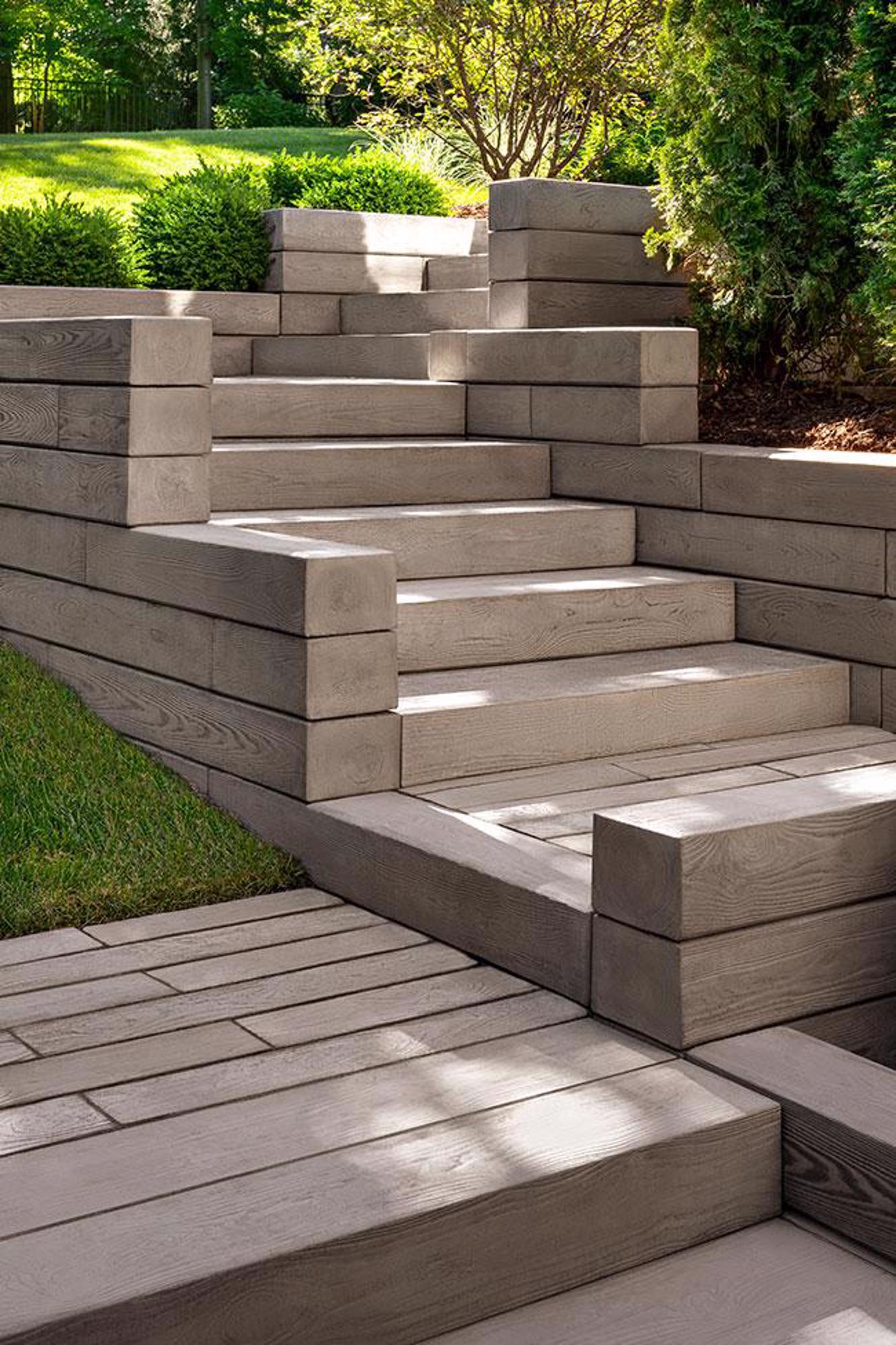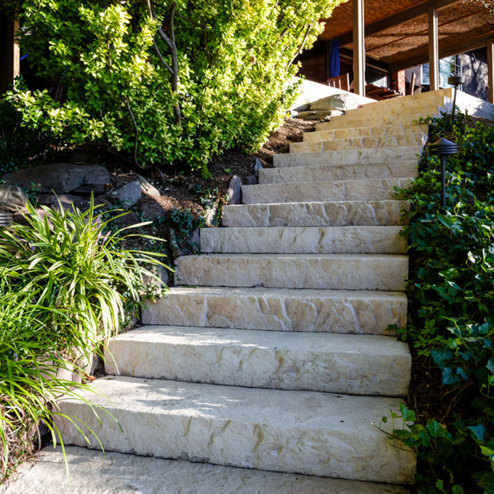Outdoor steps enhance accessibility to your property and increase curb appeal. They must be durable, safe, and well-designed.
Crafting the perfect outdoor steps involves a blend of functionality and aesthetics. These structures not only serve as a practical means for navigating the terrain but also play a significant role in the landscaping and design of your outdoor space.
Choosing the right materials, such as wood, concrete, stone, or brick, is essential for ensuring longevity and ease of maintenance. The design should complement your home’s exterior and withstand the elements, requiring minimal upkeep. Safety features like handrails and non-slip surfaces are critical, especially in areas with harsh weather conditions. Properly installed and maintained outdoor steps can greatly improve the functionality and visual appeal of your home, making it welcoming and accessible to all.
Essentials Of Outdoor Step Design
Creating the perfect outdoor steps is both an art and a science. The right design enhances safety, complements your home’s exterior, and withstands the elements. Let’s explore the essentials of crafting steps that rise to the occasion.
Choosing The Right Materials
Select materials that match your home’s style and climate.
- Wood: Warm and natural, but requires regular sealing.
- Stone: Durable and unique, yet can be slippery when wet.
- Concrete: Versatile and cost-effective, perfect for various designs.
- Brick: Classic look, but watch out for moss and mold growth.
Incorporating Natural Elements
Blend your steps with the landscape for a seamless look.
- Use stones or pavers that echo the surrounding geology.
- Integrate planters or greenery to soften the edges.
- Consider wooden steps if you’re near a forested area.
Considering Durability And Maintenance
Pick materials and designs that stand the test of time.
| Material | Durability | Maintenance |
|---|---|---|
| Wood | Medium | High – requires staining |
| Stone | High | Low – occasional cleaning |
| Concrete | High | Low – sealing recommended |
| Brick | High | Medium – watch for moss |
Choose wisely to minimize upkeep and ensure longevity. Remember, durable materials save time and money in the long run.

Credit: www.amazon.com
Integration With Landscape
Integrating outdoor steps into your landscape is more than just a functional element; it’s an art. The right steps can complement your garden and enhance the overall look of your outdoor space. Let’s dive into how to harmonize your steps with nature’s beauty.
Matching Steps With Surrounding Flora
Choosing the right materials and plants is crucial for blending steps with the landscape. Consider these tips:
- Select materials that echo the colors and textures of your garden.
- Use native plants to line the steps for a natural look.
- Integrate flowering perennials for color and vibrancy.
Imagine steps with moss-covered stones and lush ferns on each side. They look like part of the forest!
Utilizing Slopes And Natural Terrain
Work with the land, not against it. Here’s how:
- Design steps to follow the natural slope of your terrain.
- Use large flat stones on gentle slopes for stability.
- For steep areas, terraced steps can prevent erosion.
Steps that meander up a hill with the slope feel like a woodland path.
Lighting For Aesthetics And Safety
Lighting serves a dual purpose. Keep these points in mind:
| Lighting Type | Benefits |
|---|---|
| Solar Lights | Eco-friendly and easy to install |
| LED Lights | Energy-efficient and long-lasting |
| Path Lights | Illuminate the steps and enhance safety |
Add soft lighting to highlight the steps and ensure safe passage at night.
Safety First: Functional Aspects
When it comes to outdoor steps, safety never takes a backseat. The right balance between style and function ensures everyone steps confidently. Let’s explore how to make these structures safe and comfortable.
Non-slip Surfaces For All Weather
Outdoor steps face rain, snow, and ice. A non-slip surface is a must to prevent accidents. Options include:
- Textured concrete for a grip even when wet
- Anti-slip tape that sticks to the steps
- Rubber mats designed for outdoor use
Choose materials that stand the test of time and weather.
Appropriate Width And Height For Comfort
The size of each step matters for comfort and safety. Keep these standards in mind:
| Step Width | Riser Height |
|---|---|
| At least 36 inches | Between 4 and 7 inches |
These dimensions help everyone climb steps easily.
Handrails And Balusters
Handrails offer support and balance. They are vital for safety. Here’s what to consider:
- Height should be 34 to 38 inches from the step surface
- Ensure they are sturdy and comfortable to grip
Balusters, or spindles, add extra security. They prevent falls, especially for children.

Credit: www.techo-bloc.com
Step Styles And Shapes
Exploring the world of outdoor steps uncovers a variety of styles and shapes that can transform any landscape. The right steps not only ensure safe access but also add a touch of personality to your outdoor space. Whether it’s a serene garden path or a grand entrance to your home, the design of your steps plays a pivotal role.
Straight Vs. Curved
Choosing between straight and curved steps often depends on both personal taste and the layout of your outdoor area. Straight steps offer a direct path and suit minimalist landscapes. Curved steps, on the other hand, create a gentle and inviting passage that works beautifully with organic garden designs.
- Straight Steps: Ideal for modern, clean lines.
- Curved Steps: Perfect for natural, flowing spaces.
Traditional Vs. Modern Aesthetics
The battle between traditional charm and modern elegance is a constant in the realm of step design. Traditional aesthetics often involve classic materials like stone or wood, with intricate patterns and designs. Modern aesthetics lean towards sleek concrete or metal, with an emphasis on simplicity and function.
| Traditional Aesthetics | Modern Aesthetics |
|---|---|
| Wood, stone, intricate designs | Concrete, metal, clean lines |
Custom Designs For Unique Spaces
Custom designs cater to unique spaces, ensuring that no two landscapes look the same. Personalized steps can address specific challenges like uneven terrain or limited space. They can also echo the architectural style of a home, creating a cohesive look.
- Address unique landscape challenges.
- Complement home architecture.
- Create a standout feature.
Color Schemes And Textures
When designing outdoor steps, color schemes and textures play a crucial role. They add character and enhance the overall appeal of your home’s exterior. Thoughtful selection can also improve safety and complement the surrounding landscape. Let’s explore how to harmonize these elements with your home’s design.
Harmonizing With The Home’s Exterior
Outdoor steps should blend seamlessly with your home’s facade. Consider the colors of your siding, doors, and roofing. Choose a palette that either matches or contrasts tastefully. Here are some tips:
- Match the primary color of your home for a cohesive look.
- Use accent colors found in your trim or shutters to create a connection.
- Natural stone or brick can complement traditional homes.
Choosing Colors For Visibility
Visibility is key for safety. Choose colors that stand out in various lighting conditions. Here’s how:
- Light-colored steps can be easier to see at night.
- For shaded areas, opt for brighter shades to enhance visibility.
- Consider reflective materials or striping for added safety.
Experimenting With Textures
Textures not only add visual interest but also provide practical benefits. They can improve grip and reduce slipperiness. Try these ideas:
| Texture Type | Benefits | Best Used In |
|---|---|---|
| Rough | Increases traction | High traffic areas |
| Smooth | Easy to clean | Modern homes |
| Patterned | Hides wear and tear | Family spaces |
Consider a balance between aesthetics and function. Test various materials to find the perfect match for your outdoor steps.

Credit: www.techo-bloc.com
The Role Of Lighting
Lighting transforms outdoor steps, making them safe and inviting. Proper lighting ensures safety by reducing the risk of falls after dark. It also enhances the beauty of your outdoor space. Let’s explore how different lights can make your steps stand out.
Types Of Outdoor Lights
Various lights can illuminate your outdoor steps. Here’s a brief overview:
- Step lights: Embedded into the steps for a seamless look.
- Path lights: Placed alongside steps to guide the way.
- Floodlights: Offer broad lighting for general safety.
- Wall sconces: Mounted on adjacent walls to cast light.
Strategic Placement For Impact
Where you place lights is just as crucial as the lights you choose. Consider these tips:
- Highlight features: Use lights to accentuate architectural details.
- Even spacing: Maintain consistent distances between lights for uniformity.
- Minimize glare: Position lights to avoid shining directly in the eyes.
Energy Efficient Options
To save energy and costs, consider these options:
- LEDs: They use less energy and last longer than traditional bulbs.
- Solar-powered: Harness sunlight during the day to light up at night.
- Timers and sensors: Ensure lights are on only when needed.
Decorative Elements
Enhancing your outdoor steps can transform them into a charming highlight of your home’s exterior. Let’s explore some creative ways to beautify your staircase using plants, art, and seasonal themes.
Using Potted Plants And Flowers
Potted plants and flowers bring life and color to outdoor steps. Here are some tips to create a vibrant display:
- Choose plants that thrive in your climate.
- Use pots of various sizes for visual interest.
- Arrange them on different steps to draw the eye upward.
Incorporating Art Pieces
Art pieces can add a unique touch to your outdoor steps. Consider these ideas:
| Art Type | Placement Tips |
|---|---|
| Sculptures | Place at step corners for maximum impact. |
| Wall Art | Hang near the steps to create a focal point. |
Seasonal Decorations
Seasonal decorations keep your outdoor steps fun and festive all year round. Here are some ideas:
- Spring: Bright flowers and Easter themes.
- Summer: Beach themes with shells and sand.
- Fall: Pumpkins and autumn leaves.
- Winter: Lights and evergreens.
Maintenance Tips
Maintaining your outdoor steps ensures safety and preserves their beauty. Follow these simple tips to keep your steps in top condition.
Regular Cleaning Techniques
Regular cleaning is crucial for outdoor steps. Dirt and debris can make steps slippery and cause damage over time.
- Use a stiff brush to remove loose dirt.
- Wash steps with a mild detergent and water.
- Rinse thoroughly to prevent residue.
For stubborn stains, consider a gentle bleach solution or specialized cleaners.
Repair And Upkeep
Inspect your steps regularly for any signs of wear or damage. Early detection can save costly repairs.
- Check for cracks or loose parts.
- Repair small cracks with concrete filler.
- Replace damaged or worn-out treads.
Ensuring all parts are secure is vital for safety and longevity.
Longevity Tips
To extend the life of your outdoor steps, apply a sealant every few years.
- Choose a sealant suitable for the material of your steps.
- Apply according to the manufacturer’s instructions.
- Sealant protects from weather and wear.
Avoid using salt on steps in winter. It can erode materials like concrete and stone.
By following these tips, your outdoor steps will remain safe, functional, and attractive for years.
Frequently Asked Questions
Can I Buy Pre-built Stairs?
Yes, you can buy pre-built stairs from home improvement stores, online retailers, or specialty stair manufacturers. They offer various styles and materials to suit different needs and preferences.
How Much Should Outdoor Steps Cost?
Outdoor step costs vary widely, typically ranging from $1,000 to $12,000. Prices depend on material choice, size, and complexity of the design.
What Should I Use For Outdoor Steps?
For outdoor steps, use durable materials like concrete, stone, brick, or pressure-treated wood to ensure safety and longevity. Choose slip-resistant finishes to prevent accidents in wet conditions.
What Is The Maximum Riser Height For Outdoor Steps?
The maximum riser height for outdoor steps is generally 7. 75 inches, as recommended by building codes. Always verify with local regulations for specific requirements.
Conclusion
As we wrap up our exploration of outdoor steps, remember that the right design can transform your space. Consider material durability, safety features, and aesthetic appeal for the best results. Crafting functional, beautiful stairs enhances not only your home’s accessibility but also its curb appeal.
Start planning your outdoor staircase project and step up your home’s exterior today!
